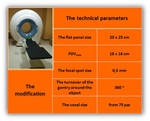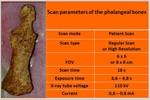This poster is published under an
open license. Please read the
disclaimer for further details.
Keywords:
Comparative studies, Digital radiography, CT, Cone beam CT, Trauma, Bones
Authors:
A. Vasiliev, E. Egorova, N. Blinov, D. V. Makarova, E. G. Gorlycheva; Moscow/RU
DOI:
10.1594/ecr2015/C-1379
Methods and materials
All the anthropological materials were provided by Research Institute and Museum of Anthropology named after D.
N.
Anuchin of Lomonosov Moscow State University (fig.
1).
In total,
24 skeleton fragments,
which were introduced by the soldiers’ remains bone material of the Imperial Napoleon Bonaparte`s army who died in 1812 war,
have been examined on modern CBCT-scanner – NewTom 5G (QR S.r.l.,
Italy).
There were a number of indisputable advantages that were applied when cone beam unit had been selected: its modification and technical parameters,
first of all (fig.
2).
CBCT of the anthropological finds were conducted with the individual scanning settings: positioning,
technical parameters and modes,
according to its anatomical origin and size (fig.
3,
4).
The obtained results were compared with the data of DMFR with direct multiple images magnification (х3,2),
which have been carried out on X-ray unit Pardus (Russia),
and MSCT,
which have been conducted on Brilliance 64 (Philips,
Holland) in 100 % (n = 24) of the samples.
All the objects were with various posttraumatic changes of different anatomical segments.
Visual inspection of each skeleton fragment had been executed to determine their anatomical origin,
size and condition of its exterior surfaces before the radiation researches.
In addition,
we have made a database of digital photographs of all the presented bones.





